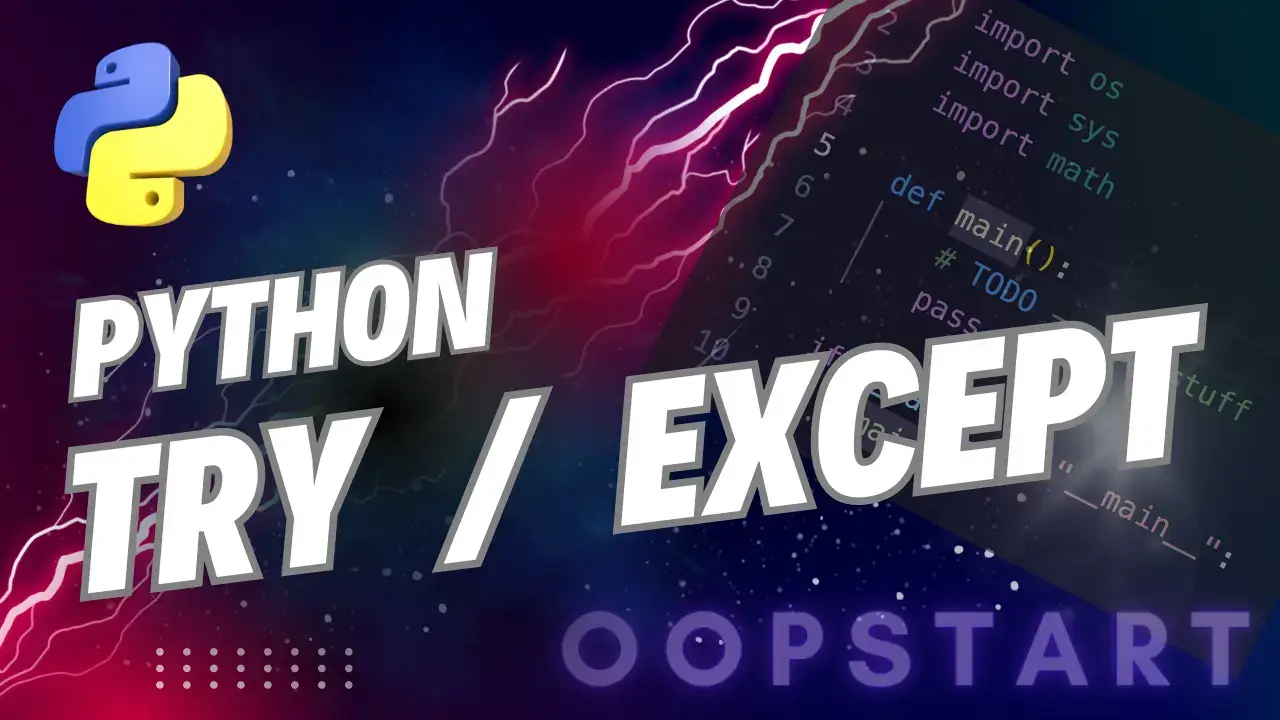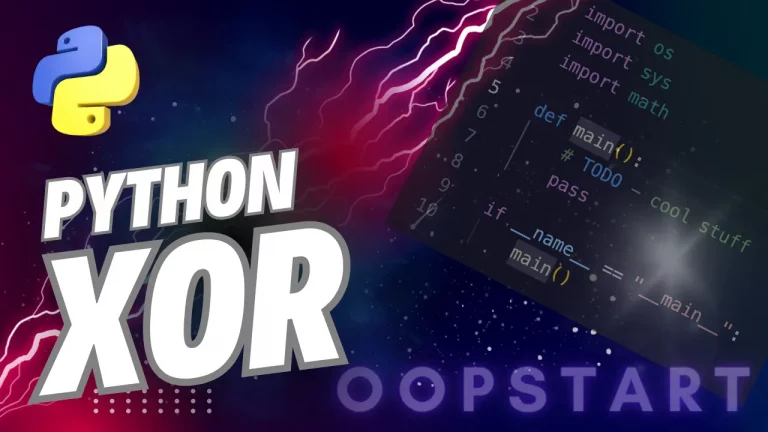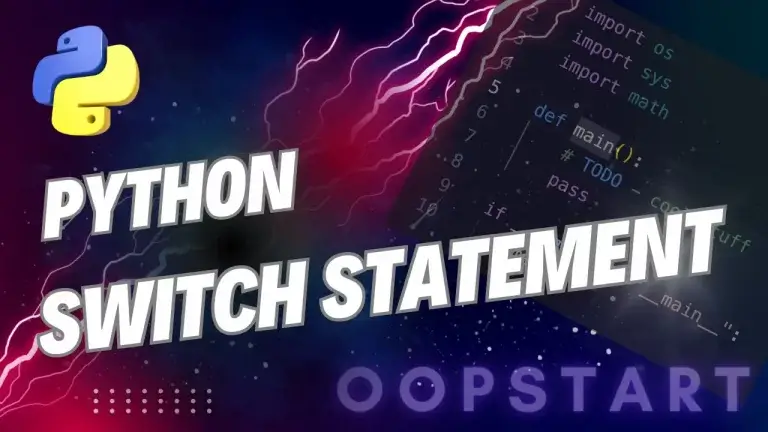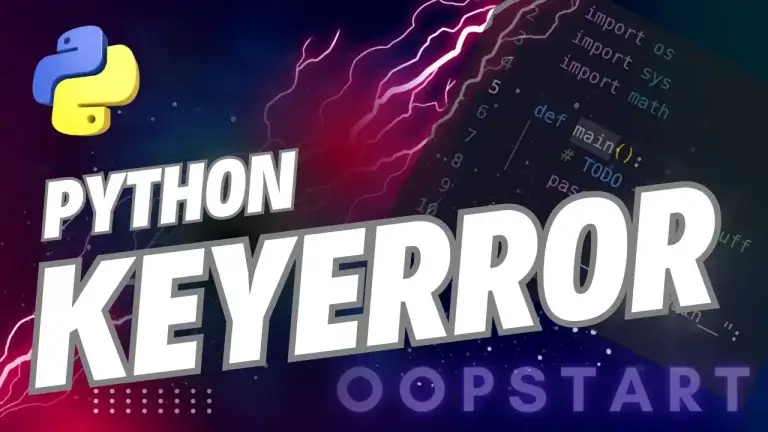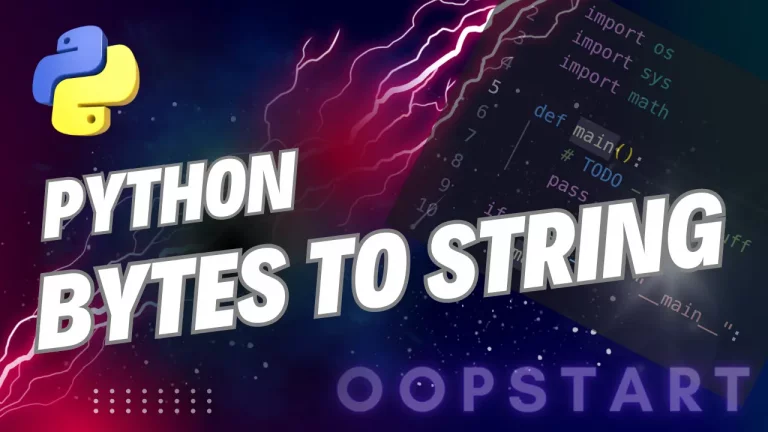Python Try Except: Deep Dive!
In Python, exceptions occur when the program encounters something unexpected that it doesn’t know how to handle. Without proper handling, exceptions will crash the program. However, Python provides a mechanism to catch and handle these exceptions using the try and except blocks, allowing your code to execute smoothly or take appropriate action when errors arise.
Using try and except helps to make your programs more robust and user-friendly, as you can manage errors gracefully and provide meaningful feedback when things go wrong.
Table of Contents
What Are Exceptions?
Exceptions are errors detected during execution. They indicate that something unexpected has occurred and the normal flow of the program cannot continue.
Common Examples of Exceptions:
- ZeroDivisionError: Trying to divide by zero.
- TypeError: Performing an operation on the wrong type.
- FileNotFoundError: Trying to open a file that doesn’t exist.
- IndexError: Trying to access an invalid index in a list or other sequence.
- KeyError: Trying to access a key that does not exist in a dictionary.
Without handling exceptions, the program stops and displays a traceback when an error occurs.
Example of an Unhandled Exception:
# This will cause a ZeroDivisionError
result = 10 / 0
Output:
ZeroDivisionError: division by zero
Basic Structure of try and except
The try block lets you test a block of code for errors, and the except block lets you handle the error if it occurs. You can also specify which type of error to catch.
Syntax:
try:
# Code that may raise an exception
except SomeException:
# Code to handle the exception
Example:
try:
result = 10 / 0 # This will raise a ZeroDivisionError
except ZeroDivisionError:
print("Error: Division by zero is not allowed.")
Output:
Error: Division by zero is not allowed.
Catching Multiple Exceptions
You can catch different types of exceptions by adding multiple except blocks, each handling a specific exception.
Example:
try:
value = int(input("Enter a number: "))
result = 10 / value
except ZeroDivisionError:
print("Error: Division by zero.")
except ValueError:
print("Error: Invalid input, please enter a number.")
In this example, the code will handle both the ZeroDivisionError (if the user enters 0) and the ValueError (if the user enters something other than a number).
Catching All Exceptions
You can catch any exception by using a bare except clause without specifying an exception type. However, this should be used with caution because it will catch all exceptions, including ones you might not expect or want to handle.
Example:
try:
result = 10 / 0
except:
print("An error occurred.")
This will catch any exception, but it’s generally better to catch specific exceptions to avoid hiding bugs.
Using else with try and except
The else block can be used in conjunction with try and except. The else block will execute if no exceptions are raised in the try block. This is useful for code that should run only when no errors occur.
Syntax:
try:
# Code that may raise an exception
except SomeException:
# Code to handle the exception
else:
# Code to execute if no exception was raised
Example:
try:
value = int(input("Enter a number: "))
result = 10 / value
except ZeroDivisionError:
print("Error: Division by zero.")
except ValueError:
print("Error: Invalid input.")
else:
print(f"Result: {result}")
Using finally with try and except
The finally block is used to define code that should run no matter what, whether an exception occurs or not. This is often used for resource cleanup tasks, such as closing files or network connections.
Syntax:
try:
# Code that may raise an exception
except SomeException:
# Code to handle the exception
finally:
# Code that will always run, regardless of whether an exception occurred
Example:
try:
file = open("data.txt", "r")
# Do something with the file
except FileNotFoundError:
print("Error: File not found.")
finally:
print("Closing the file.")
if 'file' in locals():
file.close()
In this example, the finally block will always run, whether or not an exception occurs, ensuring that the file is closed properly.
Catching Multiple Exceptions in One Block
You can catch multiple exceptions in a single except block by specifying them as a tuple.
Example:
try:
value = int(input("Enter a number: "))
result = 10 / value
except (ZeroDivisionError, ValueError):
print("Error: Invalid input or division by zero.")
In this case, the except block will handle both ZeroDivisionError and ValueError exceptions.
Raising Exceptions
Sometimes, you might want to raise an exception deliberately using the raise keyword. This is useful if you want to forcefully stop the program when a certain condition occurs or if you want to propagate an error upwards.
Example:
def divide(a, b):
if b == 0:
raise ValueError("Cannot divide by zero.")
return a / b
try:
result = divide(10, 0)
except ValueError as e:
print(e)
This will output:
Cannot divide by zero.
Handling User-Defined Exceptions
Python allows you to define your own exceptions by subclassing the built-in Exception class. This is useful when you need to create custom error types for your program.
Example:
class NegativeNumberError(Exception):
pass
def check_positive(number):
if number < 0:
raise NegativeNumberError("Negative numbers are not allowed.")
try:
check_positive(-5)
except NegativeNumberError as e:
print(e)
In this example, a custom exception called NegativeNumberError is raised when a negative number is passed to the check_positive() function.
Example of a Full try-except-else-finally Flow
You can combine all the components—try, except, else, and finally—in a single structure to handle exceptions, execute code when no exception occurs, and perform cleanup tasks.
Example:
try:
value = int(input("Enter a number: "))
result = 10 / value
except ZeroDivisionError:
print("Error: Division by zero.")
except ValueError:
print("Error: Invalid input.")
else:
print(f"Result: {result}")
finally:
print("This block runs no matter what.")
This will handle:
- Division by zero errors (
ZeroDivisionError) - Invalid input errors (
ValueError) - It will also run the
elseblock if no exception occurs, and thefinallyblock will always run at the end.
Best Practices for Using try and except
- Catch Specific Exceptions: Always try to catch specific exceptions rather than using a general
exceptblock. This makes it easier to understand what kind of errors you’re dealing with and prevents hiding bugs. Good Practice:
try:
result = 10 / 0
except ZeroDivisionError:
print("Error: Cannot divide by zero.")
Bad Practice:
try:
result = 10 / 0
except:
print("An error occurred.")
- Use
finallyfor Cleanup: If you are working with external resources (e.g., files or database connections), always use thefinallyblock to ensure that resources are released or closed, regardless of whether an exception occurs. - Raise Exceptions When Necessary: Don’t hesitate to raise your own exceptions when needed. This can be useful for validating input or enforcing certain conditions in your code.
- Avoid Silencing Exceptions: Be cautious when using a bare
exceptclause without specifying the exception type, as it can inadvertently hide errors that you may want to address.
You can learn more about Python exceptions in the official Python docs.
Key Concepts Recap
tryblock: Contains code that might raise an exception.exceptblock: Contains code to handle exceptions that occur in thetryblock.elseblock: Executes code when no exceptions are raised.finallyblock: Executes code regardless of whether an exception occurs, often used for cleanup tasks.- Catch specific exceptions for better error handling.
- Use
raiseto throw exceptions when necessary. - Handle user-defined exceptions by creating custom error classes.
Exercise:
- Divide by Zero: Write a program that takes two numbers from the user and attempts to divide them. Use
tryandexceptto catch bothZeroDivisionErrorandValueError, and display appropriate error messages. - File Handling: Write a program that attempts to open a file and read its contents. If the file doesn’t exist, catch the
FileNotFoundErrorand print a custom error message. Use afinallyblock to ensure the file is closed properly. - Custom Exception: Create a custom exception called
NegativeAgeErrorthat is raised when a user inputs a negative age. Write a program that asks for the user’s age, raises this exception for negative values, and catches it with a custom error message.
Check out our free Learn Python Programming Masterclass to hone your skills or learn from scratch.
The course covers everything from first principles to Graphical User Interfaces and Machine Learning
FAQ
Q1: What is the purpose of the try and except blocks in Python?
A1: The try block is used to test code for exceptions (errors), and the except block is used to handle those exceptions if they occur. This mechanism allows programs to continue running smoothly, even when errors arise, by providing a way to handle errors gracefully rather than crashing.
Q2: Can I use multiple except blocks for a single try block?
A2: Yes, you can have multiple except blocks for a single try block to handle different types of exceptions. Each except block can specify a particular type of exception (e.g., ZeroDivisionError, ValueError), allowing you to handle each exception type differently.
Example:
try:
value = 10 / 0
except ZeroDivisionError:
print("Cannot divide by zero.")
except ValueError:
print("Invalid input.")
Q3: What happens if an exception occurs that is not caught by any except block?
A3: If an exception is raised in the try block and there is no matching except block to handle it, the program will terminate and display a traceback, just as if no error handling was in place.
Q4: Is it a good idea to use a bare except block (without specifying an exception type)?
A4: Using a bare except block will catch all exceptions, which can hide bugs or errors you might not want to suppress. It is generally better to catch specific exceptions to avoid unintentionally ignoring critical issues.
Example of a bare except block (not recommended):
try:
result = 10 / 0
except:
print("An error occurred.")
Q5: Can I have code after except blocks that should run only if no exceptions occur?
A5: Yes, you can use the else block. The else block will run only if no exceptions were raised in the try block. This is useful when you want to execute code that should only run when everything goes smoothly.
Example:
try:
value = 10 / 2
except ZeroDivisionError:
print("Cannot divide by zero.")
else:
print("Division successful!") # Runs only if no exceptions occur
Q6: What is the purpose of the finally block, and how is it different from else?
A6: The finally block contains code that will always execute, regardless of whether an exception occurred or not. It is commonly used for cleanup operations, such as closing files or releasing resources. The else block, on the other hand, only runs if no exception occurs in the try block.
Example:
try:
file = open("data.txt", "r")
except FileNotFoundError:
print("File not found.")
finally:
print("Closing the file.")
Q7: Can I raise my own exceptions in Python?
A7: Yes, you can raise your own exceptions using the raise keyword. This is useful when you need to enforce certain conditions in your code and explicitly signal when something goes wrong.
Example:
def divide(a, b):
if b == 0:
raise ValueError("Cannot divide by zero.")
return a / b
Q8: How can I catch multiple exceptions in a single except block?
A8: You can catch multiple exceptions in a single except block by grouping them in a tuple. This way, you can handle different types of exceptions with the same code.
Example:
try:
value = int(input("Enter a number: "))
result = 10 / value
except (ZeroDivisionError, ValueError):
print("Error: Invalid input or division by zero.")
Q9: When should I use finally instead of else?
A9: Use finally when you need to ensure that some code runs no matter what, even if an exception is raised. This is typically used for resource cleanup, like closing files or database connections. Use else when you want to run some code only when no exceptions are raised in the try block.
Q10: Can I have both else and finally in the same try block?
A10: Yes, you can use both else and finally in the same try block. The else block will execute if no exceptions occur, and the finally block will always execute, regardless of whether an exception was raised or not.
Example:
try:
value = 10 / 2
except ZeroDivisionError:
print("Error: Division by zero.")
else:
print("No errors occurred.")
finally:
print("This will always run.")
Q11: How do I create a custom exception in Python?
A11: To create a custom exception, you define a new class that inherits from Python’s built-in Exception class (or one of its subclasses). This is useful when you want to raise exceptions specific to your application or logic.
Example:
class NegativeNumberError(Exception):
pass
def check_positive(number):
if number < 0:
raise NegativeNumberError("Negative numbers are not allowed.")
Q12: Is there a way to get more details about the exception raised?
A12: Yes, you can use the as keyword to capture the exception instance and access its attributes or message.
Example:
try:
value = 10 / 0
except ZeroDivisionError as e:
print(f"Error: {e}") # Output: Error: division by zero
Q13: Does Python handle exceptions efficiently?
A13: Yes, Python’s exception handling is efficient, but you should avoid using exceptions for general control flow. Exceptions are intended to handle unexpected errors, not to replace standard conditional logic.

